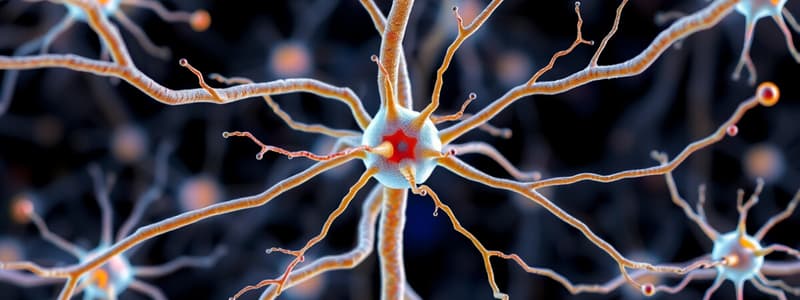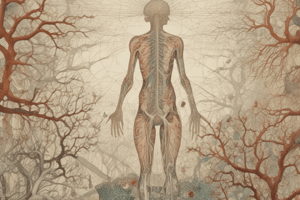Podcast
Questions and Answers
The efferent pathways of the autonomic nervous system consist of the _____ systems.
The efferent pathways of the autonomic nervous system consist of the _____ systems.
- sympathetic and parasympathetic (correct)
- sympathetic and efferent
- parasympathetic and somatic
- peripheral and afferent
A neuron that transmits a nerve impulse toward the central nervous system is called a(n):
A neuron that transmits a nerve impulse toward the central nervous system is called a(n):
- sensory neuron. (correct)
- interneuron.
- bipolar neuron.
- motor neuron.
The largest and most numerous types of neuroglia are the:
The largest and most numerous types of neuroglia are the:
- astrocytes. (correct)
- ependymal cells.
- oligodendrocytes.
- microglia.
Which of the following is not a function of the central nervous system (CNS)?
Which of the following is not a function of the central nervous system (CNS)?
The part of the nervous system that transmits impulses from the CNS to the skeletal muscle is the:
The part of the nervous system that transmits impulses from the CNS to the skeletal muscle is the:
The myelin sheath is formed by:
The myelin sheath is formed by:
Which is not true of the myelin sheath?
Which is not true of the myelin sheath?
Neurons in the CNS have less chance of regenerating for all of the following reasons except:
Neurons in the CNS have less chance of regenerating for all of the following reasons except:
Along a neuron, the correct pathway for impulse conduction is:
Along a neuron, the correct pathway for impulse conduction is:
A neuron that has only one axon but several dendrites is classified as a:
A neuron that has only one axon but several dendrites is classified as a:
Which is true of a reflex arc?
Which is true of a reflex arc?
Multipolar neurons have:
Multipolar neurons have:
Most unipolar neurons are usually:
Most unipolar neurons are usually:
Fascicles are held together by a connective tissue layer called the:
Fascicles are held together by a connective tissue layer called the:
Gray matter in the brain and spinal cord consists primarily of:
Gray matter in the brain and spinal cord consists primarily of:
The white matter of the nervous system is made up of:
The white matter of the nervous system is made up of:
Regeneration of nerve fibers will take place only if the cell body is intact and the fibers have:
Regeneration of nerve fibers will take place only if the cell body is intact and the fibers have:
Which of the following compounds cannot cross the blood-brain barrier?
Which of the following compounds cannot cross the blood-brain barrier?
A lack of which neurotransmitter is associated with Parkinson's disease?
A lack of which neurotransmitter is associated with Parkinson's disease?
Dendrites conduct impulses _____ the cell body.
Dendrites conduct impulses _____ the cell body.
Interneurons reside in the:
Interneurons reside in the:
Which of the following is the deepest connective tissue layer of a nerve?
Which of the following is the deepest connective tissue layer of a nerve?
Nerves that contain mostly afferent fibers are called _____ nerves.
Nerves that contain mostly afferent fibers are called _____ nerves.
Small distinct regions of gray matter in the CNS are called:
Small distinct regions of gray matter in the CNS are called:
The nervous system is organized to do which of the following?
The nervous system is organized to do which of the following?
In the human nervous system:
In the human nervous system:
Astrocytes attach to:
Astrocytes attach to:
One of the components of the blood-brain barrier is:
One of the components of the blood-brain barrier is:
Which of the following statements does not apply to ependymal cells?
Which of the following statements does not apply to ependymal cells?
Schwann cells have a function in the PNS that is similar to that of which cells in the CNS?
Schwann cells have a function in the PNS that is similar to that of which cells in the CNS?
The telodendria are:
The telodendria are:
What protein molecule very similar to hemoglobin temporarily stores a "backup" supply of oxygen in nervous tissue?
What protein molecule very similar to hemoglobin temporarily stores a "backup" supply of oxygen in nervous tissue?
In a three-neuron reflex arc, the afferent neurons synapse with the:
In a three-neuron reflex arc, the afferent neurons synapse with the:
The nervous system can be divided:
The nervous system can be divided:
The autonomic nervous system does not stimulate:
The autonomic nervous system does not stimulate:
The afferent pathways of the autonomic nervous system:
The afferent pathways of the autonomic nervous system:
The other term for cell body is:
The other term for cell body is:
Which of the following is not true of a three-neuron ipsilateral reflex?
Which of the following is not true of a three-neuron ipsilateral reflex?
Which is the only glia cell that is found outside of the CNS?
Which is the only glia cell that is found outside of the CNS?
The parasympathetic nervous system is part of the _____ system.
The parasympathetic nervous system is part of the _____ system.
Preparing the body for "fight or flight" describes the function of the _____ nervous system.
Preparing the body for "fight or flight" describes the function of the _____ nervous system.
Which of the following structures is (are) not found on the axon?
Which of the following structures is (are) not found on the axon?
What is the relationship between the afferent and efferent neurons of the reflex arc?
What is the relationship between the afferent and efferent neurons of the reflex arc?
If there were lesions on a bundle of myelinated fibers, what would occur?
If there were lesions on a bundle of myelinated fibers, what would occur?
Neurons have:
Neurons have:
After a stroke, there is usually some damage to brain tissue. What type of neuroglia would you expect to find invading the affected area?
After a stroke, there is usually some damage to brain tissue. What type of neuroglia would you expect to find invading the affected area?
Flashcards
Autonomic Nervous System Pathways
Autonomic Nervous System Pathways
Efferent pathways that consists of the sympathetic and parasympathetic systems.
Sensory Neuron
Sensory Neuron
A neuron that transmits nerve impulses toward the central nervous system.
Astrocytes
Astrocytes
The largest and most numerous types of neuroglia cells in the nervous system.
Somatic Nervous System
Somatic Nervous System
Signup and view all the flashcards
Schwann Cells
Schwann Cells
Signup and view all the flashcards
Neuron Impulse Pathway
Neuron Impulse Pathway
Signup and view all the flashcards
Multipolar Neuron
Multipolar Neuron
Signup and view all the flashcards
Perineurium
Perineurium
Signup and view all the flashcards
Composition of Gray Matter
Composition of Gray Matter
Signup and view all the flashcards
Composition of White Matter
Composition of White Matter
Signup and view all the flashcards
Nerve Regeneration Requirements
Nerve Regeneration Requirements
Signup and view all the flashcards
Dopamine
Dopamine
Signup and view all the flashcards
Sensory Nerves
Sensory Nerves
Signup and view all the flashcards
Nuclei
Nuclei
Signup and view all the flashcards
Central Nervous System (CNS)
Central Nervous System (CNS)
Signup and view all the flashcards
Location of Interneurons
Location of Interneurons
Signup and view all the flashcards
Epineurium
Epineurium
Signup and view all the flashcards
Nervous System Function
Nervous System Function
Signup and view all the flashcards
Autonomic vs. Skeletal Muscle
Autonomic vs. Skeletal Muscle
Signup and view all the flashcards
Afferent Autonomic Pathways
Afferent Autonomic Pathways
Signup and view all the flashcards
Study Notes
- The efferent pathways of the autonomic nervous system includes the sympathetic and parasympathetic systems.
- A sensory neuron transmits a nerve impulse toward the central nervous system.
- Astrocytes are the largest and most numerous types of neuroglia.
- Integrating sensory information, evaluating information, and initiating an outgoing response are all functions of the central nervous system (CNS).
- The somatic nervous system transmits impulses from the CNS to skeletal muscle.
- Schwann cells form the myelin sheath.
- The myelin sheath does not cover cell bodies in the brain and spinal cord.
- Neurons in the CNS have less chance of regenerating because there is no neurolemma, astrocytes fill in the path of regrowth, and microglia lay down scar tissue.
- The correct pathway along a neuron for impulse conduction is dendrite, cell body, and axon.
- A neuron with one axon and several dendrites is classified as multipolar.
- A reflex arc consists of an afferent neuron and an efferent neuron.
- Multipolar neurons have multiple dendrites and one axon.
- Most unipolar neurons are sensory neurons.
- The perineurium holds fascicles together.
- Cell bodies primarily make up gray matter in the brain and spinal cord.
- Myelinated fibers make up the white matter of the nervous system.
- Regeneration of nerve fibers will take place if the cell body is intact and the fibers have a neurilemma.
- Dopamine is a compound that cannot cross the blood-brain barrier.
- Parkinson's disease is associated with a lack of dopamine.
- Dendrites conduct impulses toward the cell body.
- Interneurons reside only in the CNS.
- The epineurium is the deepest connective tissue layer of a nerve.
- Nerves that primarily contain afferent fibers are called sensory.
- Small distinct regions of gray matter in the CNS are called nuclei.
- The nervous system detects changes in the external and internal environments and evaluates these changes.
- In the human nervous system, most of the cells are glia cells.
- Astrocytes attach to neurons and blood vessels.
- Astrocytes are components of the blood-brain barrier.
- Ependymal cells do not make up part of the blood-brain barrier.
- Schwann cells have a function in the PNS that is similar to oligodendrocytes in the CNS.
- Telodendria is none of the receptor portion of the dendrite, where the dendrite attaches to the cell body, or where the axon leaves the cell body.
- Neuroglobin, a protein molecule, is similar to hemoglobin and temporarily stores a "backup" supply of oxygen in nervous tissue.
- In a three-neuron reflex arc, afferent neurons synapse with an interneuron.
- The nervous system can be divided according to its structure, the direction of information flow, and by control of effectors.
- The autonomic nervous system does not stimulate skeletal muscles.
- Afferent pathways of the autonomic nervous system carry feedback information to integrating centers in the brain.
- Perikaryon is another term for cell body.
- In a three-neuron ipsilateral reflex, the impulse does not leave the CNS on the side opposite to the one from which it entered.
- The only glia cell found outside of the CNS is the Schwann cell.
- The parasympathetic nervous system is part of the efferent; autonomic system.
- Preparing the body for "fight or flight" describes the function of sympathetic pathways.
- An axon does not contain the axon hillock, telodendria, and synaptic knob.
- In the reflex arc, afferent neurons move signals to the CNS, and efferent neurons move signals away from the CNS.
- Lesions on a bundle of myelinated fibers result in impaired nerve conduction, weakness, loss of coordination, and visual impairment.
- Neurons have a very limited capacity to repair themselves.
- After a stroke, microglia invade the affected brain tissue.
Studying That Suits You
Use AI to generate personalized quizzes and flashcards to suit your learning preferences.




